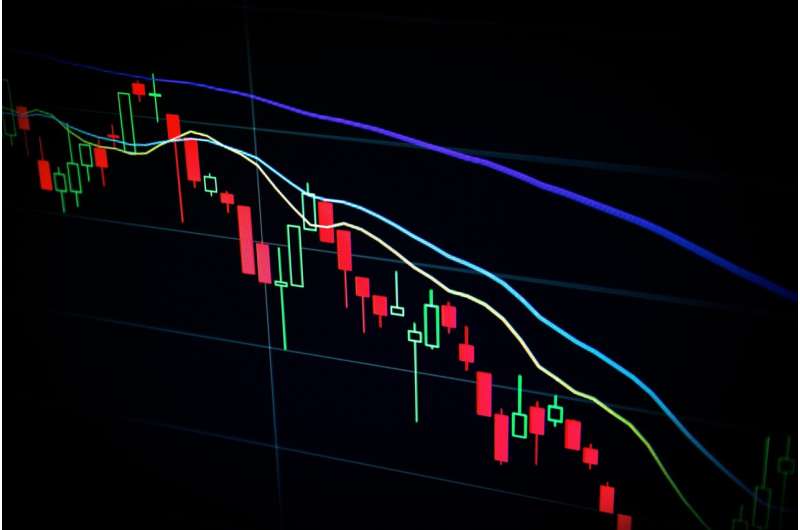This article has been reviewed according to Science X's editorial process and policies. Editors have highlighted the following attributes while ensuring the content's credibility:
fact-checked
trusted source
proofread
Study: Allowing financial trading in California's wholesale electricity market significantly reduces volatility

Forward markets—over-the-counter marketplaces that set the price of a financial instrument or asset—are used to trade a variety of instruments, including securities and commodities. In a new study, researchers measured the extent to which forward prices and spot prices (the current market price at which a given asset can be bought or sold for immediate delivery) agreed in markets with transaction costs in California, studying time periods before and after the state introduced financial trading to its wholesale electricity market in 2011.
The study found that allowing trading in this market led to a reduction in the implicit cost of trading day-ahead/real-time price differences, the volatility of these price differences, and the volatility of real-time prices. In addition, operating costs and fuel use fell on days after the introduction of purely financial participation.
The study, by researchers at Carnegie Mellon University (CMU) and Stanford University, is published in American Economic Journal: Economic Policy.
"Our results have important implications for the design of wholesale electricity markets with large shares of intermittent renewable resources," says Akshaya Jha, assistant professor of economics and public policy at CMU's Heinz College, who led the study.
Forward markets are believed to aggregate information about future spot prices and reduce the cost of producing the commodity. But it has been difficult to link increases in forward market liquidity to reductions in production costs due to the long time period over which most commodities are produced and traded. To examine changes in forward-spot price convergence after the implementation of financial trading, researchers measured the 24-dimensional vector of hourly average day-ahead prices at a location in the transmission network versus the 24-dimensional vector of hourly average real-time prices at the same location.
Using this model, they computed two measures of implied transaction costs using hourly, location-specific data on day-ahead and real-time prices from April 1, 2009, to November 30, 2012, before and after financial trading began at most pricing locations in California. The California Independent System Operator introduced financial participation on February 1, 2011, to reduce differences between day-ahead and real-time prices at more than 4,000 locations in the state's transmission network.
The study found that both measures fell substantially after California introduced purely financial participation. In addition, both measures fell more at locations where trading was restricted prior to the introduction of financial trading. This suggests that allowing financial trading resulted in day-ahead prices that better reflect real-time conditions.
The study's findings also suggest that physical market outcomes improved as a consequence of the better information encapsulated in day-ahead prices after financial trading. Namely, they show that residualized fuel cost per megawatt hour (MWh) of gas-fired output and input fuel use per MWh of gas-fired output fell after financial trading was introduced on days when the complexity of the real-time market-clearing problem was high, but not on days when complexity was low; again, indicative of the importance of improved day-ahead information.
The results remained similar regardless of whether complexity was measured using daily total demand, the daily standard deviation across locations and hours in real-time prices, or the total number of daily starts. The study's authors estimated that fuel costs per MWh fell 2% after the introduction of financial trading on high-demand days relative to low-demand days. This would result in an average $16.6 million reduction in annual total fuel costs.
As the share of electricity demand in a region grows, system operators are often required to impose more operating constraints on day-ahead and real-time markets to maintain the balance between supply and demand throughout the day. Controllable generation resources with positive startup costs are also likely to fluctuate more frequently because intermittent renewables can start and stop producing with very little notice. Rising transmission network constraints are also likely to bind as the percentage of electricity production from wind and solar resources distributed across the grid increases.
"The location-specific bids and offers submitted by purely financial participants can reduce day-ahead/real-time price differences caused by uncertainty in intermittent renewable output," explains Frank Wolak, professor of economics at Stanford University, who co-authored the study. "These financial bids and offers can also ensure that the least-cost combination of controllable resources is available to compensate for fluctuations in real-time output from intermittent renewables on high-complexity days."
More information: Akshaya Jha et al, Can Forward Commodity Markets Improve Spot Market Performance? Evidence from Wholesale Electricity, American Economic Journal: Economic Policy (2023). DOI: 10.1257/pol.20200234
Provided by Carnegie Mellon University's Heinz College





















